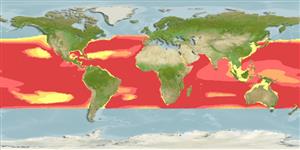>
Stomiiformes (Lightfishes and dragonfishes) >
Stomiidae (Barbeled dragonfishes) > Melanostomiinae
Etymology: Echiostoma: Greek, echieys, eos = a little viper + Greek, stoma = mouth (Ref. 45335).
More on author: Lowe.
Environment: milieu / climate zone / depth range / distribution range
Ökologie
seewasser bathypelagisch; tiefenbereich 30 - 4200 m (Ref. 58302). Deep-water; 48°N - 40°S
Eastern Atlantic: Portugal to South Africa except the Gulf of Guinea. Western Atlantic: USA south to Argentina, including the Gulf of Mexico and the Caribbean Sea. Northwest Atlantic: Canada (Ref. 5951). Also Indian and Pacific oceans.
Size / Gewicht / Alter
Maturity: Lm ? range ? - ? cm
Max length : 36.8 cm SL Männchen/unbestimmt; (Ref. 4468)
Rückenflossenstacheln (insgesamt): 0; Rückenflossenweichstrahlen (insgesamt): 12-15; Afterflossenstacheln 0; Afterflossenweichstrahlen: 14 - 18
Meso- to abyssopelagic (Ref. 58302).
Life cycle and mating behavior
Geschlechtsreife | Fortpflanzung | Ablaichen | Eier | Fecundity | Larven
Gibbs, R.H. and M.A. Barnett, 1990. Melanostomiidae. p. 308-337. In J.C. Quero, J.C. Hureau, C. Karrer, A. Post and L. Saldanha (eds.) Check-list of the fishes of the eastern tropical Atlantic (CLOFETA). JNICT, Lisbon; SEI, Paris; and UNESCO, Paris. Vol. 1. (Ref. 4468)
IUCN Rote Liste Status (Ref. 130435)
Bedrohung für Menschen
Harmless
Nutzung durch Menschen
Mehr Information
NamenSynonymeMetabolismusRäuberÖkotoxikologieFortpflanzungGeschlechtsreifeAblaichenSpawning aggregationFecundityEierEientwicklung
ReferenzenAquakulturAquakultur ProfilZuchtlinienGenetikElectrophoresesVererbbarkeitKrankheitenVerarbeitungNutrientsMass conversion
PartnerBilderStamps, Coins Misc.LauteCiguateraGeschwindigkeitSchwimmstilKiemenoberflächeOtolithsGehirngrößeSehfähigkeit
Tools
Zusatzinformationen
Download XML
Internet Quellen
Estimates based on models
Preferred temperature (Ref.
123201): 2.7 - 8.5, mean 4.3 °C (based on 2795 cells).
Phylogenetic diversity index (Ref.
82804): PD
50 = 1.0000 [Uniqueness, from 0.5 = low to 2.0 = high].
Bayesian length-weight: a=0.00302 (0.00117 - 0.00783), b=3.12 (2.89 - 3.35), in cm total length, based on LWR estimates for this (Sub)family-body shape (Ref.
93245).
Trophic level (Ref.
69278): 4.1 ±0.72 se; based on food items.
Widerstandsfähigkeit (Ref.
120179): mittel, Verdopplung der Population dauert 1,4 - 4,4 Jahre. (Preliminary K or Fecundity.).
Fishing Vulnerability (Ref.
59153): Low to moderate vulnerability (35 of 100).
Nutrients (Ref.
124155): Calcium = 15.7 [4.0, 63.4] mg/100g; Iron = 0.364 [0.112, 1.141] mg/100g; Protein = 2.9 [0.0, 6.8] %; Omega3 = 0.184 [0.058, 0.615] g/100g; Selenium = 13.4 [4.1, 53.2] μg/100g; VitaminA = 43.5 [5.6, 350.5] μg/100g; Zinc = 0.446 [0.199, 1.080] mg/100g (wet weight);
